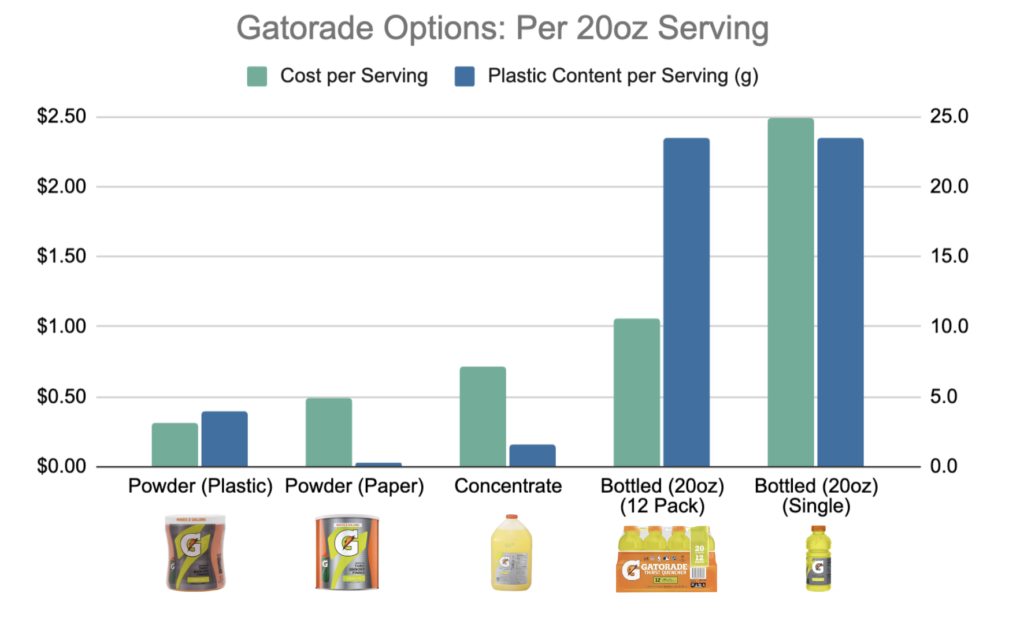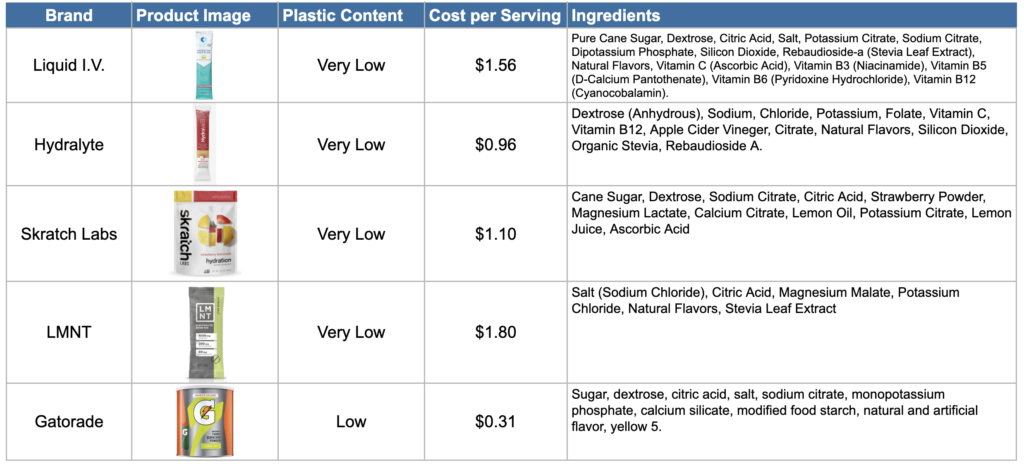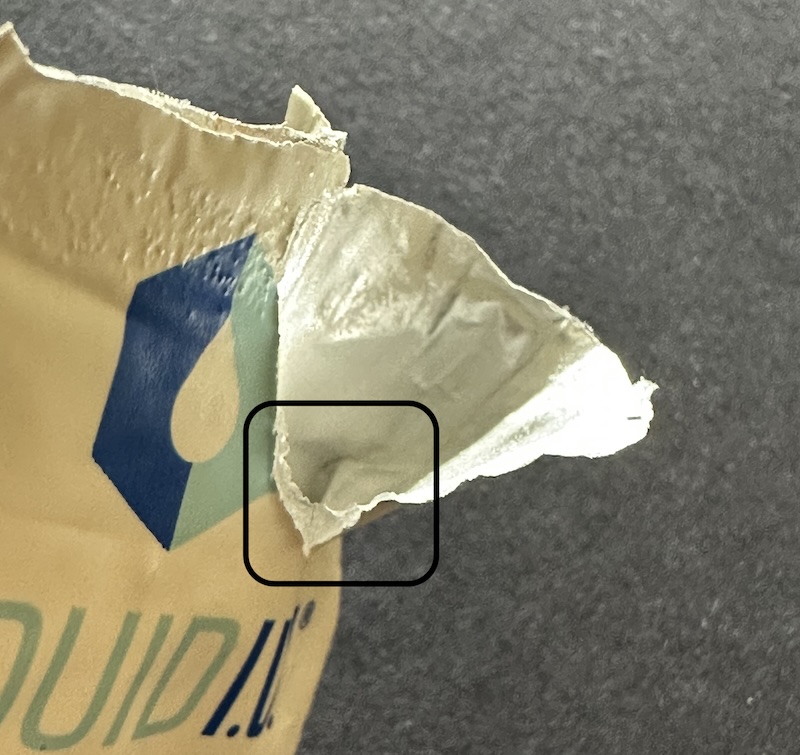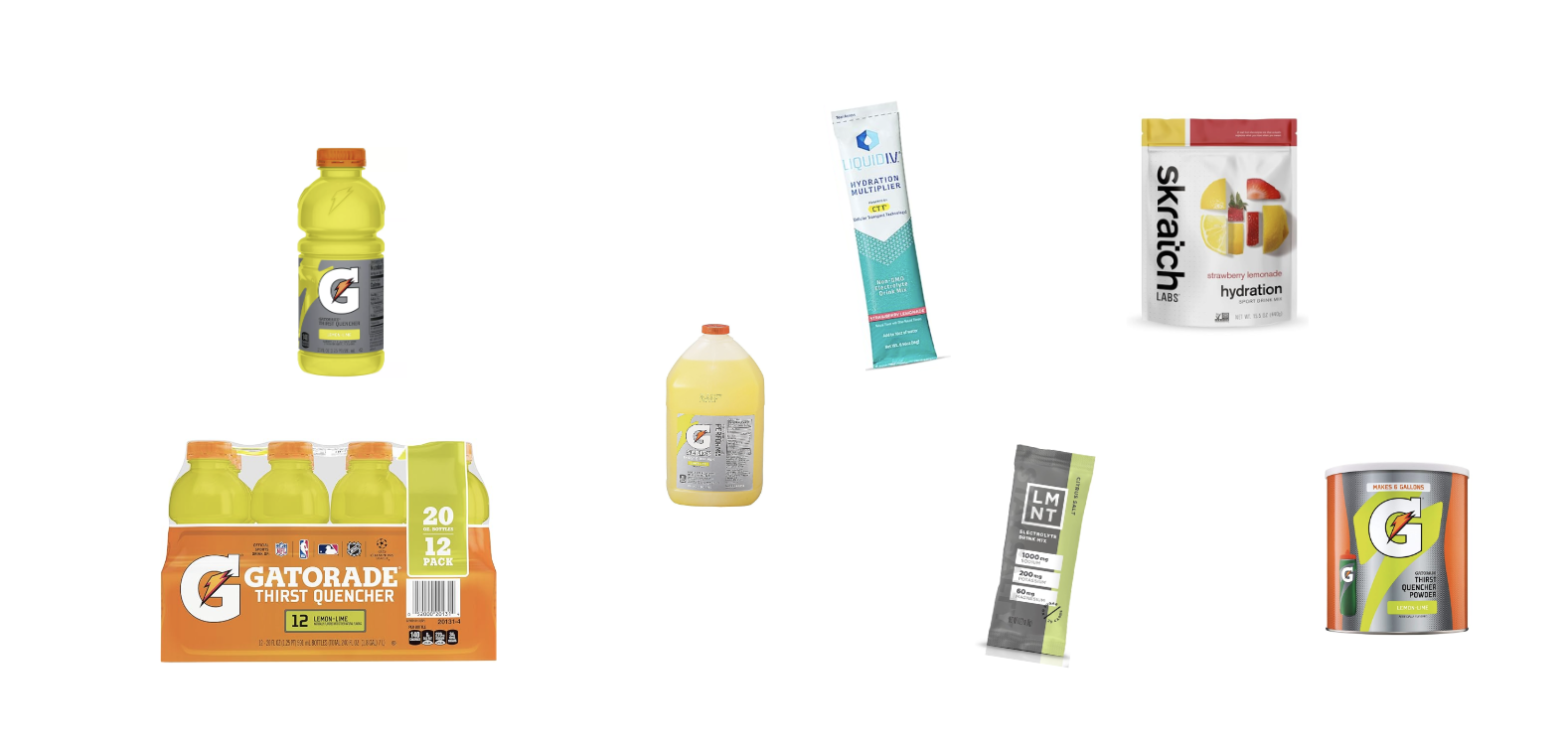Strategy 1: Use Concentrate Instead of Pre-Packaged
Instead of buying sports drinks in single-use plastic bottles, use a reusable bottle + concentrates.
To understand both the plastic and economic impact of buying bottled sports drinks vs powdered mixes or concentrates, let’s look at Gatorade – the original sports drink.
Video Breakdown: Economic & Environmental Impact
Here’s what the difference is between buying bottled Gatorade vs a concentrate or powder mix. I break this down by cost in dollars and amount of plastic produced per serving.

Key Takeaways:
- Least Expensive: Powder (Paper Container)
- Least Plastic: Powder (Paper Container)
- Most Expensive: Bottled Gatorade is much more expensive per serving
- A single bottle is 6x as expensive as the powder concentrated alternative
- A 12 pack of bottles is 2.6x as expensive as the powder concentrated alternative
- Most Plastic: Bottled Gatorade by far uses the most plastic per serving
- 6x as much plastic as powder in a plastic container
- 90x as much plastic as powder in a paper container (plastic lid)
- 14x as much as the liquid concentrate
Hydration Powders
Summary
Here is a comparison chart of the top hydration powders on the market.

Serving Size Variations
Each brand recommends a slightly different serving size. The Cost per Serving I have included here is specific to each brand’s recommendation. Here is a break down of costs and servings for each brand:
| Brand | Price (Amazon) | Servings | Recommended Serving Size | Cost per Serving |
|---|---|---|---|---|
| Liquid I.V. | $24.99 | 16 | 16oz | $1.56 |
| Hydralyte | $28.76 | 30 | 8oz | $0.96 |
| Skratch Labs | $21.93 | 20 | 12-16oz | $1.10 |
| LMNT | $21.59 | 12 | 16-32oz | $1.80 |
| Gatorade | $11.88 | 38 | 20oz | $0.31 |
Plastic Content of Packets
Most packets are composed of paper with a plastic lining. When tearing a packet open, you can see the plastic lining on the inside.

I have not been able to find reliable sources about the life cycle of these types of packets or details on their composition. It is clear however, that although there is some plastic it is minuscule in comparison to single-use bottles.
Recommendations for Hydration Brands
All brands deliver a similar mixture of salts and sugars in slightly different recipes (LMNT is and exception as it’s sugar free). Here are some recommendations based on common preferences:
No Sugar: LMNT
Ingredients: Salt (Sodium Chloride), Citric Acid, Magnesium Malate, Potassium Chloride, Natural Flavors, Stevia Leaf Extract
Low Sugar: Hydralyte
Ingredients: Dextrose (Anhydrous), Sodium, Chloride, Potassium, Folate, Vitamin C, Vitamin B12, Apple Cider Vineger, Citrate, Natural Flavors, Silicon Dioxide, Organic Stevia, Rebaudioside A.
Low Price: Gatorade
Ingredients: Sugar, dextrose, citric acid, salt, sodium citrate, monopotassium phosphate, calcium silicate, modified food starch, natural and artificial flavor, yellow 5.
Most Vitamins: Liquid I.V. – Has Vitamin C and a mix of B Vitamins
Ingredients: Pure Cane Sugar, Dextrose, Citric Acid, Salt, Potassium Citrate, Sodium Citrate, Dipotassium Phosphate, Silicon Dioxide, Rebaudioside-a (Stevia Leaf Extract), Natural Flavors, Vitamin C (Ascorbic Acid), Vitamin B3 (Niacinamide), Vitamin B5 (D-Calcium Pantothenate), Vitamin B6 (Pyridoxine Hydrochloride), Vitamin B12 (Cyanocobalamin).
Strategy 2: Make Your Own
Now that we’ve seen the ingredients for the leading hydration brands, making your own doesn’t seem too challenging. There are a host of recipes and how-to videos on the subject that will be able to guide you down this path much better than I can.
The more ingredients you can find that don’t require plastic packaging, the better! If you’re able to create your own hydration drink without the use of plastic packaging along the way, let us know how you did it in the comments.
Strategy 3: Taper To Alternative
Reducing the amount of sports drinks you consume might be the best strategy if you’ve developed a habit of grabbing a sports drink even when you don’t need it. Most of the time we think we need an electrolyte drink, we don’t.
Hydration drinks are recommended by most doctors only when signs of electrolyte imbalance start to occur or during extended and extraneous exercise when an imbalance is likely to occur. For most of us, this is a rare occasion. You can learn more about symptoms of electrolyte imbalance and alternatives to electrolyte drinks from the experts at Scripps.
I used to have the habit of grabbing a sports drink in lieu of water. After learning this was unnecessary and significantly increasing my sugar intake, I kicked the habit the same way I overcame my morning caffein addiction: a slow wean.
Here’s a simple plan that can help guide you through the process of breaking the sports-drink habit with little to no discomfort:
General Guidelines To Keep In Mind
- Slow and Steady – Each week you should only be able to notice a very slight difference in the taste of your sports drink.
- Consistency is Key – If you feel a strong urge for a sports drink or that the diluted version is too weak, adjust the timing and dilution accordingly. If you slip up a day or two, don’t worry about it. Just get back to your normal schedule.
- Tracking is Half The Battle – The tracking may seem like a small piece but is actually critical. I have tracked many of my own habits over the years. The act of simply writing down each time I take a certain action I’m trying to adjust makes me more aware of it which is at least half the battle.
- Celebrate The Wins – You can track the amount of sugar you’re taking out of your diet and the amount of money you’re saving… then celebrate them! I’ve found that taking a moment to congratulate myself after hitting a milestone boosts my motivation considerably.
- Substitutions and Adjustments – You may also want to experiment with some ingredients from Strategy 2, or even a dash of lemon juice to help make plain water not feel so boring. Tweak the regimen to fit your needs and to optimize for your desired outcome.
Week 1-2: Initial Dilution
- Baseline Measurement: Start by measuring how much sports drink you consume daily. A notebook or the Notes app on your phone should suffice.
- Initial Dilution: Replace 25% of your sports drink with water. For example, if you drink 4 cups of sports drink daily, replace 1 cup with water. If drinking from a bottle, pour a 1/4 into another container and then fill the rest with water. If using a mix, just use 3/4 of what you would normally use.
Week 3-4: Increased Dilution
- Increased Water Ratio: Now, replace 50% of the sports drink with water.
- Taste Adjustment: Your taste buds will begin adjusting to less sweetness. Stay attentive to how your body feels with this change. You can adjust up or down a little bit accordingly. The key is to make the change slight, so it’s easy to manage and you can keep your streak going.
Week 5-6: Further Reduction
- Majority Water: Increase the water content to 75%, reducing the sports drink to just a quarter of your intake. At this point you should be adding sports drink to water instead of the other way around.
- Progress Check: You’re drinking half as much sugar and you’re probably noticing that you aren’t any less hydrated and may actually feel better.
Week 7-8: Nearly There
- Minimal Sports Drink: Reduce the sports drink to just a small splash, about 10% of your drink, with the rest being water. You may even be able to use a substitute at this stage like a dash of lemon juice.
- Observe Changes: Notice any changes in your energy levels or how you feel overall. This can be motivating.
Week 9+: Transition to Water
- Complete Transition: Now, switch entirely to water.
- Flavor Alternatives: If you miss the flavor, consider adding natural flavors to your water, like a slice of lemon, cucumber, or mint leaves.
Additional Tips:
- Track Your Progress: Keep a journal or use an app to track your daily intake and progress. This helps with awareness of your intake and motivation as you can look back and see how much sugar (and plastic) you’ve cut out of your diet.
- Mindful Drinking: Going forward, be conscious of why you’re drinking sports drinks (for taste, habit, energy) and how water can be a healthier alternative.
Next Steps
If this guide has helped you to reduce your plastic use, let us know about it by commenting here or sending us a note on one of our social media channels.
AND if you have additional recommendations related to this topic, let us know so we can share with the community. Thanks!

